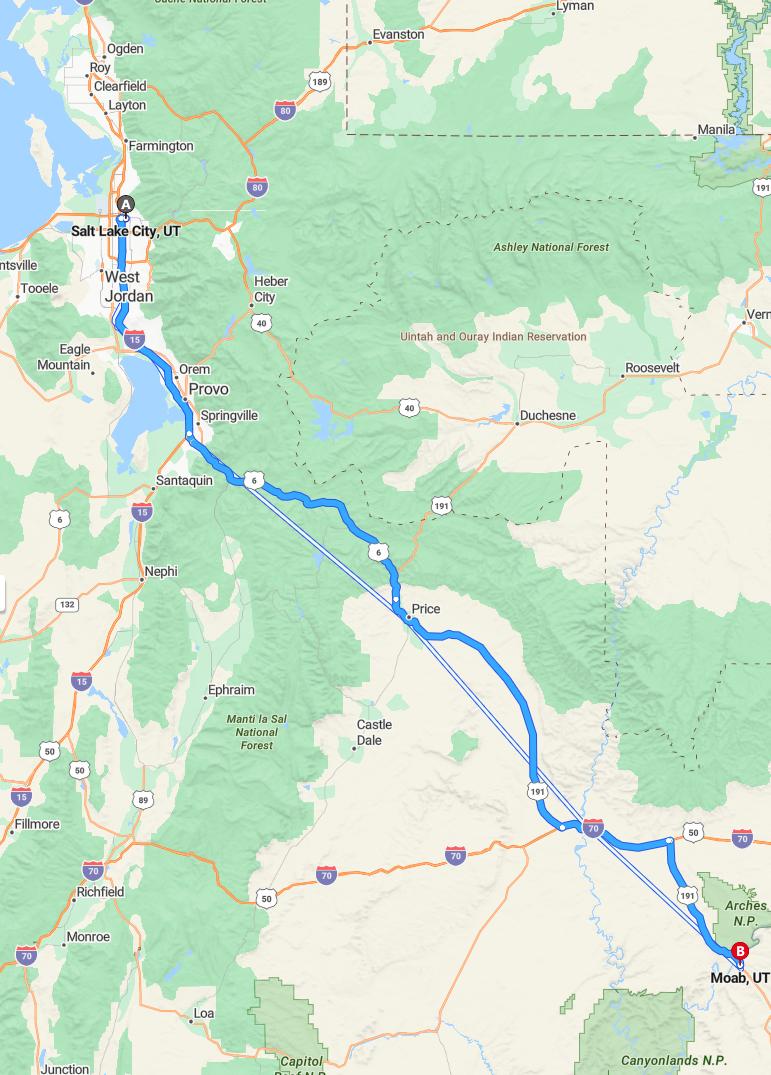Distance and estimated driving time
The drive from Salt Lake City to Moab covers approximately 234 miles, taking an estimated 4 hours and 2 minutes via US-6 E and US-191 S. This scenic route offers travelers a chance to experience Utah's diverse landscapes, including desert terrains and rugged canyons. The journey is relatively straightforward, making it a popular choice for visitors heading to Moab's outdoor adventures. Planning ahead ensures a smooth trip, allowing enough time for breaks and sightseeing along the way.
Driving route
Traveling from Salt Lake City to Moab offers a scenic journey through Utah's diverse landscapes. Starting in Salt Lake City, motorists typically pass through West Jordan, a vibrant suburb with shopping and dining options. Continuing southeast via Provo, travelers can enjoy views of Utah Lake and the surrounding mountains. The route then traverses through Price, a historic mining town that provides a glimpse into Utah's industrial past. Finally, arriving in Moab, visitors are greeted by iconic red rock formations and access to outdoor adventures like Arches and Canyonlands National Parks.

Best time to travel
The optimal time to travel from Salt Lake City to Moab is during the spring and fall seasons, when the weather is pleasantly mild and outdoor activities are most enjoyable. Spring, from March to May, offers blooming deserts and comfortable temperatures, making it ideal for sightseeing and exploring natural attractions. Fall, from September to November, provides cooler days and vibrant autumn foliage, enhancing the scenic drive through Utah's stunning landscapes. Summer months can be quite hot, especially in July and August, so if traveling then, it's best to start early in the morning or later in the evening to avoid the high temperatures.
Scenic stops along the way
Traveling from Salt Lake City to Moab offers numerous scenic stops that highlight Utah's stunning landscapes. In West Jordan, travelers can enjoy picturesque views of the Wasatch Mountains, providing a perfect backdrop for a quick photo stop. Continuing to Provo, visitors can explore the beautiful Rock Canyon and Utah Lake, both offering tranquil natural scenery. As you approach Moab, the breathtaking red rock formations and Arches National Park awe-inspiring vistas create a memorable conclusion to the journey.
Road conditions and weather considerations
Traveling from Salt Lake City to Moab, drivers should be aware of varying road conditions and weather throughout the journey. The route passes through diverse terrains, including urban areas like West Jordan and Provo, where roads are typically well-maintained, but they may experience heavy traffic during peak hours. As you approach Price and Moab, especially in winter months, snowy or icy conditions can occur, requiring cautious driving and possibly chains or all-wheel drive. It's essential to check current weather forecasts and road alerts before departure to ensure a safe trip through this scenic yet potentially challenging route.
Fuel stations and rest areas
Travelers driving from Salt Lake City to Moab will find several fuel stations and rest areas along the route, ensuring convenient stops for refueling and relaxation. In West Jordan and Provo, numerous gas stations are available to quickly top off or take a break, with amenities such as restrooms and convenience stores. Continuing toward Price, drivers can access additional fueling options, along with designated rest areas equipped with picnic spots and shaded seating. As you approach Moab, well-maintained fuel stations and rest stops provide the perfect opportunity to recharge, making the trip comfortable and stress-free.
Cultural and historical landmarks nearby
As you drive from Salt Lake City to Moab, you'll encounter a rich tapestry of cultural and historical landmarks along the route. In West Jordan, you can explore local museums that highlight Utah's pioneer history, while Provo offers insights into early Mormon settlements at the Provo Pioneer Village. Continuing on to Price, visitors can learn about the region's Native American heritage at nearby archaeological sites. Finally, Morab itself is a gateway to exploring natural wonders and historic landmarks like Arches and Canyonlands National Parks, showcasing Utah's diverse cultural and natural history.
Recommended travel tips and safety advice
When driving from Salt Lake City to Moab, it's important to plan your route carefully, stopping at key locations like West Jordan, Provo, and Price to rest and refuel. Ensure your vehicle is well-maintained, with tires, brakes, and fluid levels checked before departure, especially as some stretches can be remote. Stay alert for changing weather conditions and wildlife, and always follow posted speed limits and traffic signs to ensure safety on the scenic but sometimes challenging roads. Carry ample water, snacks, and emergency supplies, and let someone know your travel plans, so you're prepared for a safe and enjoyable journey through this beautiful region.
Local dining and accommodation options
Traveling from Salt Lake City to Moab offers a variety of local dining and accommodation options to enhance your journey. Along West Jordan and Provo, you'll find numerous restaurants serving regional and international cuisine, as well as cozy hotels and motels perfect for resting before continuing your adventure. In Price, visitors can enjoy local diners and family-run eateries that showcase the area's flavors, with several lodges and inns available for overnight stays. As you reach Moab, a range of boutique hotels, campgrounds, and unique dining establishments provide memorable experiences amidst breathtaking scenery, making your trip both comfortable and flavorful.
Alternative routes and detours
Travelers from Salt Lake City to Moab have several alternative routes and detours to consider. One option is to take the scenic Highway 6 through Price, which offers beautiful views and may help avoid traffic on the more direct routes. For those seeking a more adventurous path, detours through Uinta National Forest or the Arches National Park can add memorable sightseeing opportunities. It is advisable to check current road conditions and closures beforehand, as seasonal weather or construction can impact these alternative routes.
